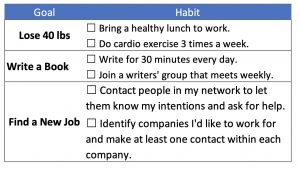Unfortunately, most of us are terrible at achieving our big goals. 80% of us give up on our New Year's goals by the first week in February.
We aren't great at achieving strategic business goals either. In a recent survey of senior executives, 88% said strategic initiatives were critical to organizational success, yet over 50% said their organization was NOT good at executing these initiatives.
The problem isn't us; it's the way we approach big goals.
The problem with how we approach our big goals is that we focus on the goal itself rather than the small, daily habits we must master to achieve the goal.
The most important thing we can do to achieve bold goals is to identify the critical few habits we must repeatedly do to fuel our success and hold ourselves accountable for committing to those habits.
Please stick with me here! I teach you how to achieve any big goal, personal or business, by identifying and measuring the critical habits to fuel your success. I'll even include a few free downloads to kickstart your progress.
Let's do this!
Achieving Your Big, Personal Goals
As exciting and complicated as our big goals might be, the way we realize them is pretty simple. It all comes down to having the right daily and weekly habits.
Cause (Habit) = Effect (Goal)
The habit is the cause, and that's what deserves our full attention.
So let's use these examples of personal goals:
- Lose 40 lbs
- Write a book
- Find a new job.
Like most bold goals, we won't achieve them overnight. Realistically, some might take more than a year. When there is no immediate gratification, we'll need to break goals down into a few actionable steps we can take daily or weekly (habits) and measure our progress against these habits, not the end goal.
Here's the three-step process.
#1. Identify the Habits
Here are a few possibilities using the example goals from above:

So why only 30 days? Dream big, but act small. It's overwhelming to think of all the things you will ultimately need to do to achieve a meaningful goal. So don't! Only tackle it 30 days at a time. After 30 days, you can evaluate which habits are moving the needle and any adjustments you need to make.
#2. Set Implementation Intentions
Use the following framework to build a precise intention:
I will _______(action) at ________(time) in ________(location).
The implementation intentions for the three example goals we used earlier might look something like this:

#3. Measure What Matters
Track your progress! What gets measured gets done, as the saying goes, and it feels great to check the box on a commitment you've made to yourself. I recommend making it easy to do and easy to see.
I've created a habit tracker template you can download to help you build your critical few habits and intentions and jumpstart the process. Click HERE to download my habit tracker template.
Note: If you prefer an app, you can check out Habit Tracker. It's simple, elegant, and free. Pro tip: if you choose to use any habit tracker app, make sure you specifically use the intention sentence as the habit. For example, use “I will write for 30 minutes each day in my study after the kids go to bed.” rather than “Write for 30 Minutes Each Day”. That specificity makes the intention stronger and the habit stickier.
Achieving Your Strategic Business Goals
It should be no surprise that the secret to achieving strategic business goals is the same secret for achieving personal goals. The only difference is in the terminology we use.
Habits are essentially lead measures in the business context. Lead measures are those key actions you must do daily or weekly to achieve a goal. So we'll refer to our business habits as “lead measures.”
Here's the four-step process for business goals:
#1. Identify the Lead Measures
Pro Tip: Here's a link to my blog post, Leveraging Lead Measures, that includes a free down, “Identifying Lead Measures Worksheet.”
#2. Set Implementation Intentions
In the Harvard Business Review article, “Get Your Team to Do What It Says It's Going To Do,” the author refers to people who set these types of intentions as “if-then planners.”
Research suggests that if-then planners are three times as likely as others to reach their goals.
That is a profound advantage and an opportunity for your team to leverage this approach to get the desired results.
#3. Measure What Matters
Review these dashboards weekly and monthly to stay committed, on-track, and to review any adjustments that might be appropriate. With many strategic projects, particularly new and innovative projects, we find that the actions we thought we needed to take are not working. This review is the perfect time for the team to adjust or pivot to keep moving closer to the goal.
#4. Align Incentives With Lead Measures
But strategic “change the business” goals will typically span more than one performance review cycle. Yet, they don't make their way into the quarterly, semi-annual, or annual review cycle or the incentive systems. To avoid this miss, ask yourself this question:
How are we aligning our incentives to reward those daily, weekly actions that drive us closer to achieving our long-term strategic goals?
I recommend integrating the team's lead measures for strategic initiatives into the incentive and performance structure. This approach rewards the team for the daily and weekly behaviors they demonstrate to ensure your business achieves those strategic goals.
Bonus: Make Habits Stick With Identity Habits
At the core of all of our behaviors lie the beliefs we have about ourselves. To create a sustainable habit, we must decide who we want to be and act consistently like that person until we convince ourselves we have become that version of ourselves.
To create identity habits, begin by reframing goals based on who we want to become, not just what we want to achieve. For example:
- The goal is not to write a book but to become a writer.
- The goal is not to run a marathon but to become a runner.
- The goal is not to lose 40 lbs but to become a healthy person.
Using the first example, what habits would someone who is a writer have mastered? A good writer would most likely have a daily writing habit. That translates into, “I'm the kind of person who writes every day.” These identity-based habits are sustainable, and they serve us beyond annual goals. To make it easier to build your identity habits, I've created a free guide you can download by clicking the link below.
FREE Download How to Create Identity Habits
I'll send you the How to Create Identity Habits Guide so you can start building your identity habits now!
“Motivation is what gets you started. Habit is what keeps you going.” — Jim Ryun
Motivation is terrible fuel to rely on to power our actions. Habits, however, keep us moving forward. Whether it's a personal goal or a business goal, the key to achieving bold goals requires that we identify the critical few habits we must repeatedly do to fuel our success AND hold ourselves accountable to committing to those habits.
You've got bold goals, and the world needs you to achieve them. Use these techniques for creating implementation habits, identity habits, and lead measures to join the few 10% – 20% of people who will achieve their goals! And please share this post with anyone who's got big dreams like you and would appreciate a little encouragement.


